Beatus legend
According to G. Dummermuth. The Swiss Apostle St. Beatus, Legend and History. Max Birkhäuser & Carl Huber, Basel 1889
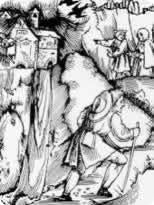
The Shepherds of Sundlauenen
Long ago, the inhabitants of Lake Thun lived in isolation, practicing paganism. Under the guidance of the Druids, they sacrificed humans to their gods. Sacrifices were performed on Hohlenstein, but also on the rocky platform in front of the large cave beneath the Balmfluh. The wise Druids had once inhabited this cave before a terrifying dragon drove them out and terrified the entire region. One day, two strangers, dressed in heavy cloth and carrying long pilgrim's staffs, came wandering over the Brünig Pass. They walked along Lake Brienz to the Bödeli, crossed the Lombach stream, and arrived in the ancient village of Sundlauenen. The two were given a warm welcome by the friendly shepherds, who had to tell them about their journey. Their homeland, they told them, was in faraway England, and they had come to bring good news to the inhabitants of this region. Beatus told them about the benevolent God in heaven and about Jesus Christ, his Son, who was sent into the world to save humanity. The people of Sundlauen asked Beatus to stay with them and instruct them even more fully in this new path of faith. He promised that he would gladly stay, but that he should not be a burden to anyone. They should allocate a cave nearby to him where he and Justus could live; that was all they needed.
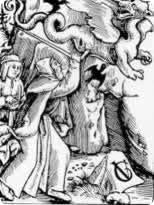
The Dragon's Cave
The shepherds said such a cave was not far away, and would be perfectly suitable as a dwelling place, were it not inhabited by a horrible dragon, a terror to man and beast. "The earth belongs to the Lord, and everything in it!" said Beatus joyfully. "In the name of Almighty God, I will drive out the dragon." The Sundlaueners advised Beatus against doing so, but Beatus remained firm. While the shepherds slept, he watched and prayed with his faithful companion. At dawn, the two set out and arrived at the cave at sunrise. The dragon greeted the strange arrivals with a terrible hiss. Beatus, however, raised his pilgrim's staff and summoned the horrible lindworm in the name of Almighty God. With a helpless howl of rage, the dragon sprang forth and plunged into the lake, which boiled overhead.
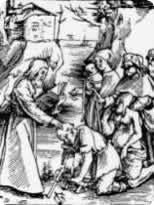
Beatus apostolice work
Beatus had come to this wild region to serve as a messenger of faith. On that memorable morning, when the dragon plunged into the lake with a violent roar that echoed eerily from the mountains, the people hurried there; they wanted to witness the great miracle and pay high homage to the hero. But Beatus taught them that honor was not due to him, but only to the God of the Christians, who had power greater than all the might of the Evil Enemy. They listened to him willingly, and not just on that day. They came again and again, listening to his words. Soon, Beatus was no longer a stranger to them, but a friend and father who visited the people in their huts, spoke kindly to them, comforted them, healed them, and prayed for their recovery. They helped him build a small church near the cave where they could gather for worship. Beatus also became known on the other side of the lake. Especially in Einen, many believed, were baptized, and formed a Christian community, which was overseen by Justus. There, too, the faithful gathered every Sunday in the newly built church.
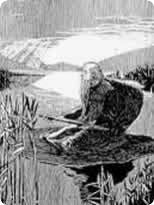
Coat ride and fence sticking
When Beatus sailed across the lake to the villages on the other shore, he used his cloak as a sail. From him, the locals learned how to use sails. The wind regularly blew downstream in the morning and upstream in the evening, which was favorable for Beatus's preaching tours. The unusual sight of Beatus sailing with his cloak led many people to believe that he only had to spread his cloak on the water and sit on it, and it would carry him dry across the lake. People told the story of how he once wanted to sail across the lake when his vehicle broke down. It twisted and rocked and even drove him backward toward the shore. His rowing was in vain. He thought for a moment and suddenly remembered a fence pole, which he had torn out while climbing down, as a walking stick and oar for the crossing. He regretted his wrongful act of stealing someone else's property and returned the pole to where he had taken it. Now he succeeded in crossing the lake in his cloak; like a swan he reached the other shore.
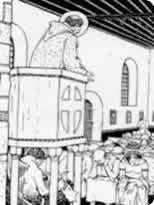
P. Kammüller?
Beatus drove to his student Justus in Einen for the Easter sermon that afternoon. When he arrived, Justus had already begun preaching, so Beatus sat in the back pew so as not to disturb anyone. In the little church, however, it was so humid that several people began to sleep. Beatus was saddened to see this; but he was even more horrified when he saw Satan himself sitting under the pulpit. He was writing the names of those who were dreaming on a goat's hide, thus forfeiting their salvation on Judgment Day. Beatus was in a desperate situation. He would have liked to wake the sleepers so they wouldn't miss Justus's Amen and thus fall under the devil's power. But he wasn't allowed to disturb the service. Suddenly, things took an unexpected turn: There were so many sleepers in the church that Satan no longer had room on his skin to write them down. He tried to stretch them out between his teeth and claws; He pulled and pulled... until his skin burst, and he banged his head so hard on the pulpit that it reverberated throughout the entire church. Beatus laughed loudly at the stupid devil, and everyone in the church woke up just before the preaching Justus said "Amen."
The helpful dwarves
In those days, there were still dwarves living in hidden rock crevices. These shy little mountain men were happy to help the quiet, good people in their homes and fields. However, they provided their assistance in secret, to catch people off guard. If anyone tried to overhear them, they would never return. They soon became friends with Beatus, for he had driven the dragon out of the cave, which they too had been terribly afraid of and had therefore hidden deep within the cave for a long time. Now they emerged into the light of day again. For some, their help was too good. Most of all, they served Beatus. Just as the prophet Elijah was once fed by ravens, so they provided for Beatus's livelihood. They brought him dry wood, drew water from the stream, brought him chamois milk and fine cheese, vegetables and ripe fruit, and much more. But Beatus needed very little for himself; he gave most of it to the poor and suffering of the area. The dwarves brought him many rare medicinal plants from the mountain peaks, which he used as medicine for the sick. In his garden, beaver clover and lilies bloomed alongside the many herbs.
Fall of the city of Roll
West of Merligen, the town of Roll once existed. It was large and powerful. Its inhabitants had acquired great wealth through gold mining and trade. But with the gold, they also acquired arrogance, revelry, and a life of debauchery. The Rollians were known far and wide for their arrogance. Only a few had come to Beatus to be taught Christianity; most remained firmly anchored in their Roman paganism. Beatus set out to support the few disciples there in their faith and to win the others for Christ. When he arrived in Roll, however, none of his followers showed up; they had all hidden for fear of the unbelievers. This wicked mob, however, fell upon Beatus with mockery and insults. They pulled his beard and threatened to strangle him. Then a pious couple who lived away from the city welcomed him under their shelter. Sadly, Beatus returned to his cave. On his way through the Balmholz, he encountered his friends, the dwarves of Oberhusen. He had to tell them the reason for his distress. Other dwarves had watched from the pointed cliff how shamefully the venerable man had been treated in Roll. Now the measure of the outrage was full, and so the dwarves decided to take terrible revenge. They busily began hammering in the crevices of the pointed cliff, pouring water on it and letting it freeze to cause the rock to burst. They also let a Cassandra cry resound from the heights.
"City Roll, take us with your
Lots! The pointed slope is split;
Schlegel and Wegge hold their ground.
Let's go to the Stampach!"
The warning was in vain. A terrible doom descended upon the city. The mountain trembled, flaming lightning flashed from a black storm cloud, and amidst terrifying thunder, a collapse occurred, burying the city and its inhabitants deep beneath boulders, rubble, and debris. A large part of the city sank into the lake. Only the hospitable house where Saint Beatus had been welcomed was spared.
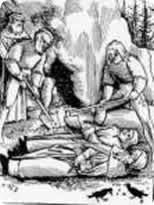
St. Beatus Death and Burial
Despite all his hardships and self-sacrificing service for the welfare and salvation of humanity, Saint Beatus reached a ripe old age. He was never a burden to anyone; he supported many with advice and deeds, showing them the way in times of hopelessness and need. When Saint Beatus felt that he must die, he summoned Justus, his companion. Justus cared for him in his final days. Saint Beatus asked Justus to summon all those who had been converted to Christ through his testimony. They all flocked to Saint Beatus. He took his leave of them, encouraged them to remain steadfast in their faith, and blessed them. Then he closed his eyes to awaken again in heaven. His body was buried in the cave. Later, Justus, in accordance with his wishes, was also buried next to Saint Beatus. The Saint Beatus Cave—as it was called from then on—became a place of prayer and grateful remembrance of the one who had brought the Good News to the right shore of Lake Thun. Never since has the preaching of the gospel ceased.
Beatus story or legend
Over the years, historians have held different views about the saint who was highly revered in the Middle Ages as St. Batt:
- Is he, as legend tells us, the British
Monk, ordained a priest by Peter himself
and sent to convert the Helvetians to Christianity
convert?
- Is he a saint of the Theban Legion who lived in the 3rd century?
century to Lake Thun?
- Is he one of the 12 companions of Columban, who travelled through northern Switzerland shortly after 600
pulled?
- Is Beatus the Beatus of Honau in Alsace, who led the monastery from 722 - 774,
that is said to have sent its monks to Switzerland?
- Or is the Swiss Beatus with his namesake the Bishop of Vendôme in
France, about which the same dragon legend is told?
We don't know... What we think we know about Beatus comes largely from the pen of the Minorite Daniel Agricola, who described the saint's life in 1511. The text, written in the style of a "vita," whitewashes Beatus's personality with the usual saintly clichés.
A possible historical Beatus can no longer be identified, so most historians today relegate Saint Beatus to the realm of legend. However, there is one more opinion about Saint Beatus that has some merit: in the Middle Ages, monastery founders and church founders were usually elevated to the status of saints. The monasteries in their vicinity often established a pilgrimage for them, a house pilgrimage. This could also be true of the founder of Interlaken Monastery, Blessed (Latin: Beatus) of Oberhofen. He could have been the Beatus who ended his life as a hermit in St. Beaut's Cave and was venerated there as a saint.
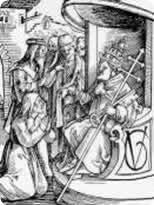
The cult
According to popular belief, the Celts themselves offered sacrifices to their gods at the Beatus Caves. It's quite possible that the large cave beneath the Balmfluh was a pre-Christian place of worship or pilgrimage. Its location also supports this: Celts viewed caves and springs as places of proximity to God and healing.
During the Christianization process, such places of worship persisted; they received a church or chapel, thus becoming Christian pilgrimage sites. Who built the first chapel near the caves in the early 12th century or earlier, and to whom it was dedicated, is no longer known. The oldest document attesting to the parish of Sancto Beato dates from 1230. Very soon, St. Beaten came under the care of the Interlaken Monastery, which subsequently also provided the priests and promoted the Beatus cult to the best of its ability.
The 15th century was the heyday of St. Beatus veneration. St. Beatus became something of a patron saint, venerated as a helpful saint throughout the Swiss Confederation and far beyond. Crowds visited the saint's grave and implored his help and healing. During this period, the word "wallfahren" (to go on pilgrimage) was replaced by "batten," a word that has been passed down to this day in the expression "äs het batter" (it has been successful). Naturally, the word refers to pilgrimages that ended successfully, such as that of Burkhard Münch from Basel, who was said to have been cured of his serious illness at St. Beatus in 1422. The city of Bern, patron of the Interlaken Monastery, also supported the St. Beatus cult: In 1439, the plague broke out in the country, claiming many victims. In this dire situation, the government in Bern ordered a general procession of penance and supplication to St. Beatus's resting place. At least one family member participates in such prescribed pilgrimages. Bern has repeatedly called on the neighboring communities of St. Beaten to maintain the pilgrimage route at their own expense to ensure good accessibility.
In 1494, the government issued a begging letter to allow the monastery's masters to mount the relics of Saint Beatus in silver. The collection was so rich that a silver-clad shrine could be made to be placed above the altar.
May 9, St. Beatus Day, is celebrated as a major folk festival. A 15th-century saying preserves some of Saint Beatus's great glory for our time:
"Yippee, today is Saint Batten Day!
Away all care, away all trouble;
Let him who can rejoice be happy!"
Until the Reformation, St. Beaten, along with Einsiedeln, remained the most visited pilgrimage site in the Swiss Confederation.
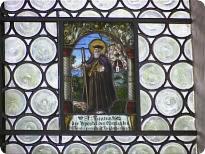
Iconoclasm
In 1528, Berne opted for the Reformation. The monasteries were dissolved, mass and the veneration of saints were abolished. St. Beaten was also to be evacuated, the images burned, and the relics buried. Whether this happened as the Bernese chronicler Anselm wrote, or whether images and relics from St. Beaten found their way over the Brünig into Central Switzerland with the Old Believer captain of Zug, Schönbrunner, remains an open question. Zug, Lucerne, Schwyz, and others later claimed to possess relics of St. Beatus. In any case, the then parish priest, Martin Freund, apparently did not prevent the Central Swiss from their actions, which incurred the wrath of Berne. He was ordered to close the chapel. He was dismissed soon afterward.
Crusades to St. Beaten
St. Beaten was cleared, the images and altars removed, and the Reformed service was established. But that didn't stop pilgrims from central Switzerland from making their way over the Brünig to the venerable St. Batt in droves.
Bern is now taking radical action against the Beatus cult because it fears for the success of the Reformation in the Oberland.
In 1530, Bern had the "St. Battenloch" (St. Batten Hole) buried. Four years later, the pilgrimage site was completely demolished, and the cave had to be walled up again. In 1535, the people of Beatenberg received their own church in the village.
But the pilgrimages don't stop. Groups of pilgrims from the original cantons repeatedly visit the holy site. Accompanied by priests, they tear down the wall in front of the cave to gain access to the sanctuary. Bern repeatedly has the wall rebuilt. This was the case in 1537, 1547, and 1566, when a four-foot-thick wall was erected. Despite bans and threats of punishment, the pilgrims refuse to be intimidated and keep coming back. They cannot understand why anyone wants to prevent them from making the pilgrimage to St. Beaten, to which they have been accustomed since time immemorial. In Obwalden, people want to free and secure the pilgrimage to St. Beaten, just as the Crusaders once did, by force if necessary. An armed conflict threatens. But Obwalden finds little support for its endeavor among the Old Believers and is forced to give in at the Diet of Baden in 1570, where it demands freedom of pilgrimage.
After 1590, streams of pilgrims again flocked to St. Beaten. A writing by the Jesuit Canisius called on the pilgrims, despite all the difficulties, to visit the saint at Lake Thun. Bern responded to this attack swiftly: the pilgrims were to be arrested and punished with heavy fines. In 1593, the cave had to be walled up again. Gradually, the number of pilgrimages declined, but even this last wall was torn down again, and it is said that pilgrims from central Switzerland continued to make pilgrimages to St. Beaten until the beginning of the last century.
Saint Beatus today
Today, Saint Beatus is venerated only in central Switzerland. A chapel dedicated to him stands in Obsee near Lungern. Beatus is also the patron saint of several churches, including the Hofkirche (Court Church) in Lucerne, above whose main portal he still fights hostile dragons.
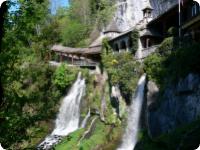
Saint Beatus Caves
They remain a popular destination for young and old. Safely and expertly guided, visitors can venture into the depths of the mysterious cave, visit the cell with Saint Beatus, or simply sit by the water and listen... and... those who take the time to listen can still feel it today. It's no coincidence that this place has been a place of healing throughout the centuries. It is endowed with many beauties, rich in spirit and history, in sweetness and security, refreshing and invigorating, even today.